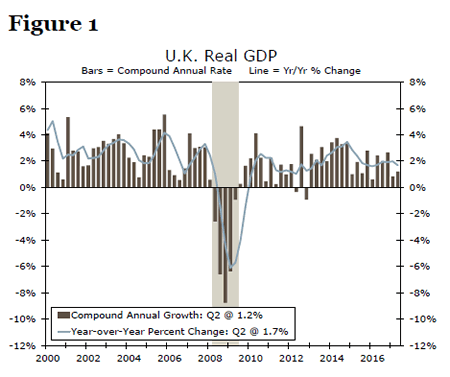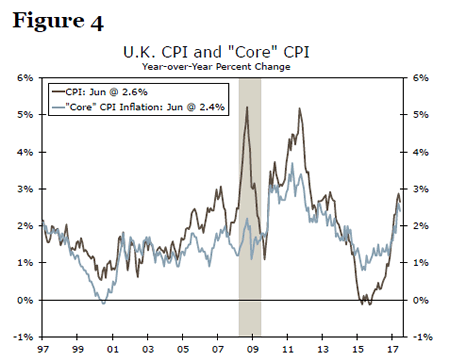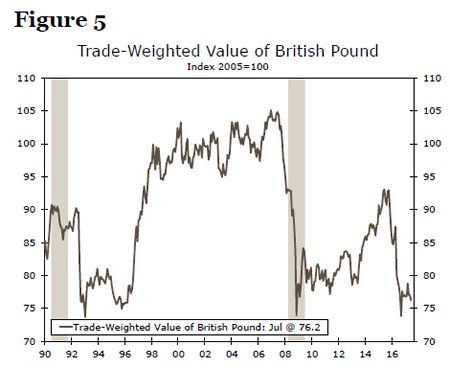Executive Summary
Economic growth in the United Kingdom remained modest in Q2, growing at a 1.2 percent annualized rate over the quarter. Monthly data suggest that a deceleration in consumer spending has played a role in the downshift in the British economy as rising inflation and stagnant wage growth have taken a bite out of household purchasing power. This combination of rising inflation, sluggish wage growth and tepid economic activity has put the Bank of England (BoE) in a bit of a bind. Although five members voted to keep Bank Rate unchanged at 0.25 percent at the last policy meeting on June 14, three members voted to hike rates by 25 bps at that meeting. We believe that the views of the majority will continue to prevail, and that policymakers at the BoE will refrain from raising rates through at least the end of 2017 as inflationary pressures from weak sterling begin to subside. Looking ahead, we forecast that real GDP growth will strengthen modestly in 2018 as some of the forces that have led to a slowdown this year reverse, although uncertainty related to Brexit continues to lurk in the background as a major downside risk to the economy.
Economic Growth Trudges Along in Q2
The 1.2 percent annualized growth rate in Q2 matched expectations (Figure 1). The data are preliminary and could be subsequently revised. Moreover, a breakdown of the overall GDP data into its underlying demand components will not be released until next month. In general, the 1.7 percent year-over-year growth rate that was registered in the second quarter indicates that the underlying pace of economic growth in the United Kingdom is only modest at present.

As noted above, a detailed breakdown of the Q2 GDP data into its underlying demand components is not yet available. Service industries accounted for all of the growth, while production-oriented industries such as manufacturing and construction contracted in the quarter.
In addition, monthly data suggest that a deceleration in consumer spending has played a role in the downshift that is underway in the British economy. Yes, real retail sales grew 1.5 percent (not annualized) on a sequential basis in the second quarter. On a year-over-year basis, however, real retail spending was up only 2.6 percent in Q2, which clearly represents a slowdown relative to the breakneck pace of the past few years (Figure 2).

This ratcheting back in the pace of consumer spending reflects a combination of two factors. First, although the unemployment rate has dropped to only 4.5 percent, the lowest rate in more than 40 years, wage growth in the United Kingdom remains painfully slow (Figure 3). At the same time, CPI inflation has shot higher due, at least in part, to the marked depreciation of sterling in the wake of last year’s Brexit referendum (Figure 4). The combination of slow wage growth and higher inflation means that growth in real disposable income (i.e., purchasing power) has taken a hit. With the household savings rate at an all-time low of only 1.7 percent of disposable income, consumers have needed to reduce spending growth due to slower growth in real income.


Bank of England Likely To Remain on Hold
The surge in the overall rate of CPI inflation in the past year or so presents a conundrum to policymakers at the Bank of England (BoE). The British government tasks the BoE with maintaining an inflation rate of two percent over the medium term. With CPI inflation well above the BoE’s target at present, some members of the Monetary Policy Committee (MPC) have felt compelled to tighten policy. Although five members voted to keep Bank Rate unchanged at 0.25 percent at the last policy meeting on June 14, three members voted to hike rates by 25 bps at that meeting. The next policy meeting is scheduled for August 3.
We believe that the views of the majority will continue to prevail, and that the MPC will refrain from raising rates through at least the end of 2017. As noted above, the depreciation of sterling—it weakened 20 percent on a trade-weighted basis between late 2015 and late 2016 (Figure 5)— helped to push CPI inflation higher. However, the trade-weighted value of sterling has largely moved sideways over the past few months, and we expect it to remain more or less stable in coming months. Therefore, the inflationary impulses hitting the economy from higher import prices should start to dissipate. The recent decline in energy prices should also help to reduce inflation. Although the overall CPI inflation rate could very well drift higher over the next month or two, we look for it to recede later this year as disinflationary forces come to the fore. Meanwhile, although we forecast that real GDP growth in the United Kingdom will firm somewhat, the pace of growth will generally remain lackluster through the end of the year (Figure 6). In our view, the combination of receding inflation and sluggish GDP growth should stay the MPC’s hand for the remainder of the year.


We look for real GDP growth to strengthen modestly in 2018 as some of the forces that have led to a slowdown this year reverse. Namely, the decline in the CPI inflation rate that we forecast should help to boost growth in real disposable income again, which should translate into stronger growth in consumer spending. Stronger growth in the global economy, especially in the Eurozone, to which the United Kingdom sends 40 percent of its exports, should also contribute positively to real GDP growth. In that regard, the volume of British exports was up more than 7 percent in the first two months of Q2 relative to the same period in 2016. As the economic outlook improves, we look for the MPC to hike rates in late spring/early summer 2018. That said, any tightening that the MPC should undertake likely will remain gradual. We also expect that the MPC will maintain the size of its quantitative easing program at £445 billion (£435 billion government bonds plus £10 billion corporate bonds) through at least the end of 2018.
Brexit: The Elephant in the Room
The United Kingdom has built extensive economic and financial ties with other European Union (EU) countries over the past 44 years during which it has been an EU member. Exports to and imports from the other EU members accounts for one-half of British trade, and those countries own one-half of the directly invested capital in the United Kingdom. London has become the unquestioned financial capital of Europe.
But the decision by the United Kingdom to leave the EU means that new relationships governing these economic and financial ties must now be renegotiated by March 2019, and there is considerable uncertainty regarding the ultimate configuration of these new relationships. Will goods and services continue to be traded freely between the United Kingdom and other EU members after 2019? Will citizens of other EU countries be allowed to live and work in the United Kingdom after it leaves the EU? Will the unfettered access to European financial markets that the EU "passport" gives to London-based financial institutions continue? At this time, nobody knows the answers to these and myriad other questions regarding the Brexit process.
This uncertainty appears to be affecting investment spending in the United Kingdom. Survey data that measure investment intentions, which tend to be highly correlated with actual investment spending, weakened throughout 2016 (Figure 7). Investment intentions have rebounded somewhat this year, but they generally remain low. Until some of the uncertainty regarding the Brexit process is cleared up, many businesses in the United Kingdom may adopt a wait-and-see attitude regarding investment spending. We do not believe the uncertainty is enough to derail the current economic expansion in the British economy, but we freely acknowledge the risk that the economy weakens significantly more than we and other forecasters anticipate. Stay tuned.

Conclusion
Economic growth in the United Kingdom has slowed from its cycle-high reached in 2014, but the deceleration has not been as sharp as originally feared in the wake of Brexit. That said, production in investment-oriented sectors of the economy remains soft, and consumer spending has begun to suffer amid wages that have struggled to maintain their purchasing power. The recent stabilization of the sterling should help relieve some of the inflationary pressure caused by imports, and stronger growth in the global economy, especially in the Eurozone, should also contribute positively to real GDP growth. This in turn should keep the policymakers at the BoE on hold through at least the end of 2017. As such, we look for a modest strengthening in the U.K. economy over the next 18 months. The ongoing negotiations related to Brexit will likely continue to loom over the U.K. economy over the next few years, representing a major downside risk moving at a glacial pace.













